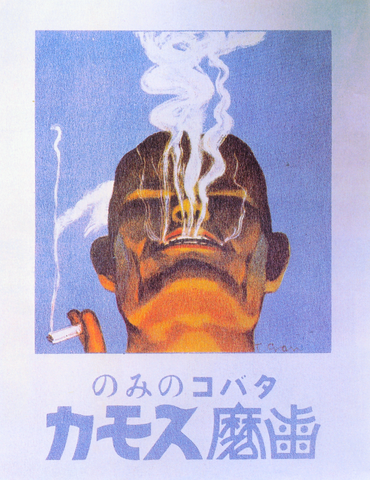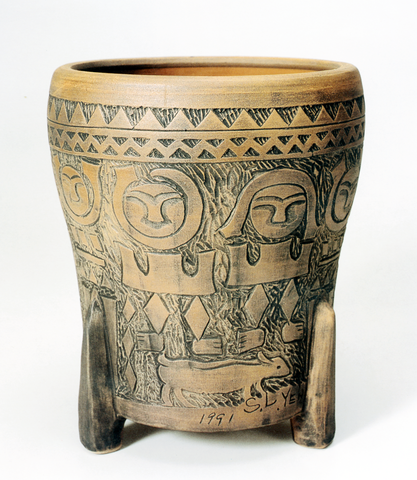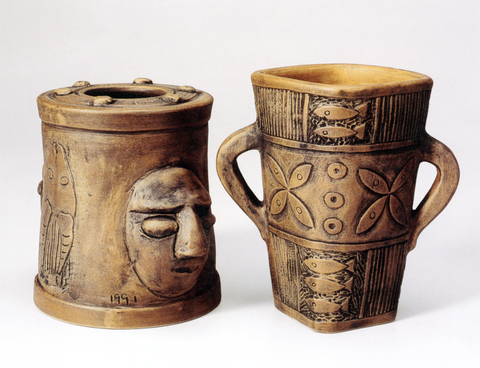Had Yan Shui-long (
Apart from being an outstanding oil painter, Yan devoted his life to handicrafts from his youth, trying several times -- though without success -- to set up his own handicraft school. He also wrote extensively on the subject in his later years.
Pioneer of Taiwanese Handicraft: special exhibition of Yan Shui-long's 100th anniversary, (

PHOTO COURTESY OF TAIPEI CRAFT DESIGN CENTER
To shed light on the life of a dedicated master, the exhibition also includes a reconstruction of Yan's studio, his collection of exotic handicrafts from other countries and some well-designed personal items like his glasses cases. Together, these create a rounded picture of an artist who lived out his art in his life.
Well-known as the "Father of Taiwanese handicraft," Yan juggled teaching, painting and making handicrafts. In preparation for a retrospective in 1997, which was meant to celebrate his 95th birthday, Yan painted eight hours a day in the hope of presenting an impeccable selection of works. He was tired out and slipped in his bathroom, sustaining a bone fracture. He soon died from complications resulting from an operation on the injury.
Throughout his life, Yan advocated the merits of handicrafts. "Art is not just a painting on the wall," Yan once said. Handicrafts not only help improve living standards in a developing country but foster people's appreciation of beauty, Yan said. They can give people a lift in a country that values wealth and longevity, because their influence on people are more far-reaching than fine art.

At a time when most artists in Taiwan would not demean themselves to make product designs or advertisements, Yan created many of these kinds of works. His series of 12 advertisements for Japan's Smoca tooth powder is the best part of the exhibition.
"Since freshening up after getting up in the morning is your style, how can you not use Smoca after smoking?" the advertisement asks in Japanese with a simple yet inviting picture of a bathroom door left ajar.
Yan's package designs for Taichung's Tai Yang Tang (

Rural life and Aboriginal culture inspired him most. Yan expressed his admiration for Aboriginal esthetics in his clay works. The stock imageries of snakes, fish and human figures are adjusted to depict the true life style of Aboriginal people.
Mural mosaics are another part of Yan's celebrated works. Apart from Rural Life mosaic in Taipei's Chian-tan Park and Sports in Taichung Stadium, the exhibition includes large pictures of many other mosaics which are located in less-visited places across the country.
"Pioneer of Taiwanese Handicraft," an exhibition celebrating Yan Shui-long's 100th anniversary will run until Oct. 26 at the National Taiwan Craft Research Institute's Taipei Craft Design Center, 9F, 20 Nanhai Rd, Taipei (

Many people noticed the flood of pro-China propaganda across a number of venues in recent weeks that looks like a coordinated assault on US Taiwan policy. It does look like an effort intended to influence the US before the meeting between US President Donald Trump and Chinese dictator Xi Jinping (習近平) over the weekend. Jennifer Kavanagh’s piece in the New York Times in September appears to be the opening strike of the current campaign. She followed up last week in the Lowy Interpreter, blaming the US for causing the PRC to escalate in the Philippines and Taiwan, saying that as

Taiwan can often feel woefully behind on global trends, from fashion to food, and influences can sometimes feel like the last on the metaphorical bandwagon. In the West, suddenly every burger is being smashed and honey has become “hot” and we’re all drinking orange wine. But it took a good while for a smash burger in Taipei to come across my radar. For the uninitiated, a smash burger is, well, a normal burger patty but smashed flat. Originally, I didn’t understand. Surely the best part of a burger is the thick patty with all the juiciness of the beef, the

This year’s Miss Universe in Thailand has been marred by ugly drama, with allegations of an insult to a beauty queen’s intellect, a walkout by pageant contestants and a tearful tantrum by the host. More than 120 women from across the world have gathered in Thailand, vying to be crowned Miss Universe in a contest considered one of the “big four” of global beauty pageants. But the runup has been dominated by the off-stage antics of the coiffed contestants and their Thai hosts, escalating into a feminist firestorm drawing the attention of Mexico’s president. On Tuesday, Mexican delegate Fatima Bosch staged a

Would you eat lab-grown chocolate? I requested a sample from California Cultured, a Sacramento-based company. Its chocolate, not yet commercially available, is made with techniques that have previously been used to synthesize other bioactive products like certain plant-derived pharmaceuticals for commercial sale. A few days later, it arrives. The morsel, barely bigger than a coffee bean, is supposed to be the flavor equivalent of a 70 percent to 80 percent dark chocolate. I tear open its sealed packet and a chocolatey aroma escapes — so far, so good. I pop it in my mouth. Slightly waxy and distinctly bitter, it boasts those bright,